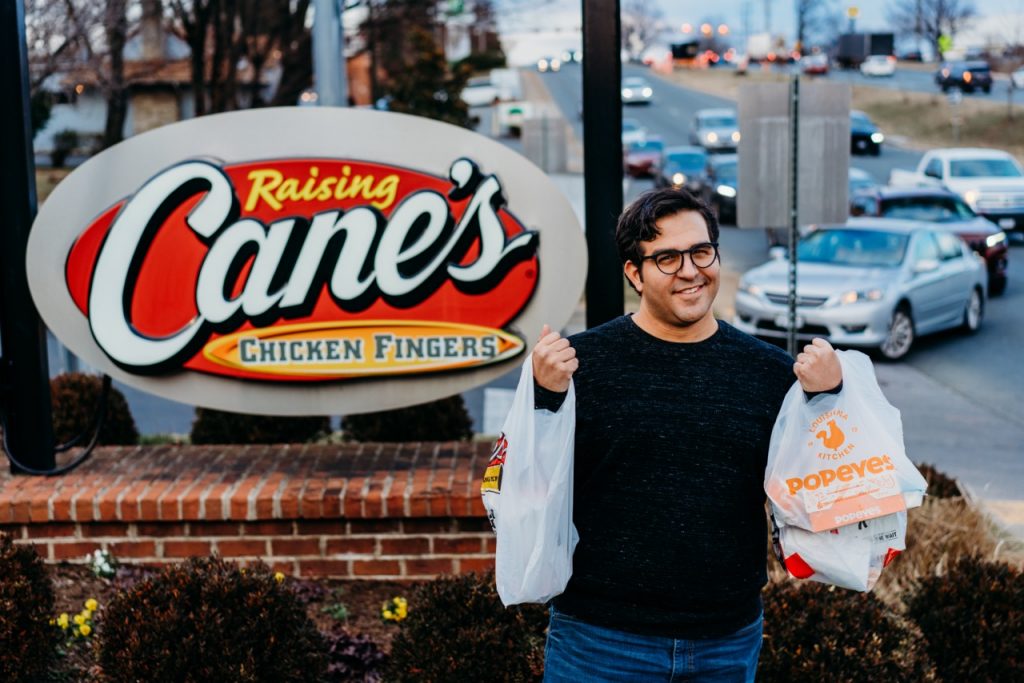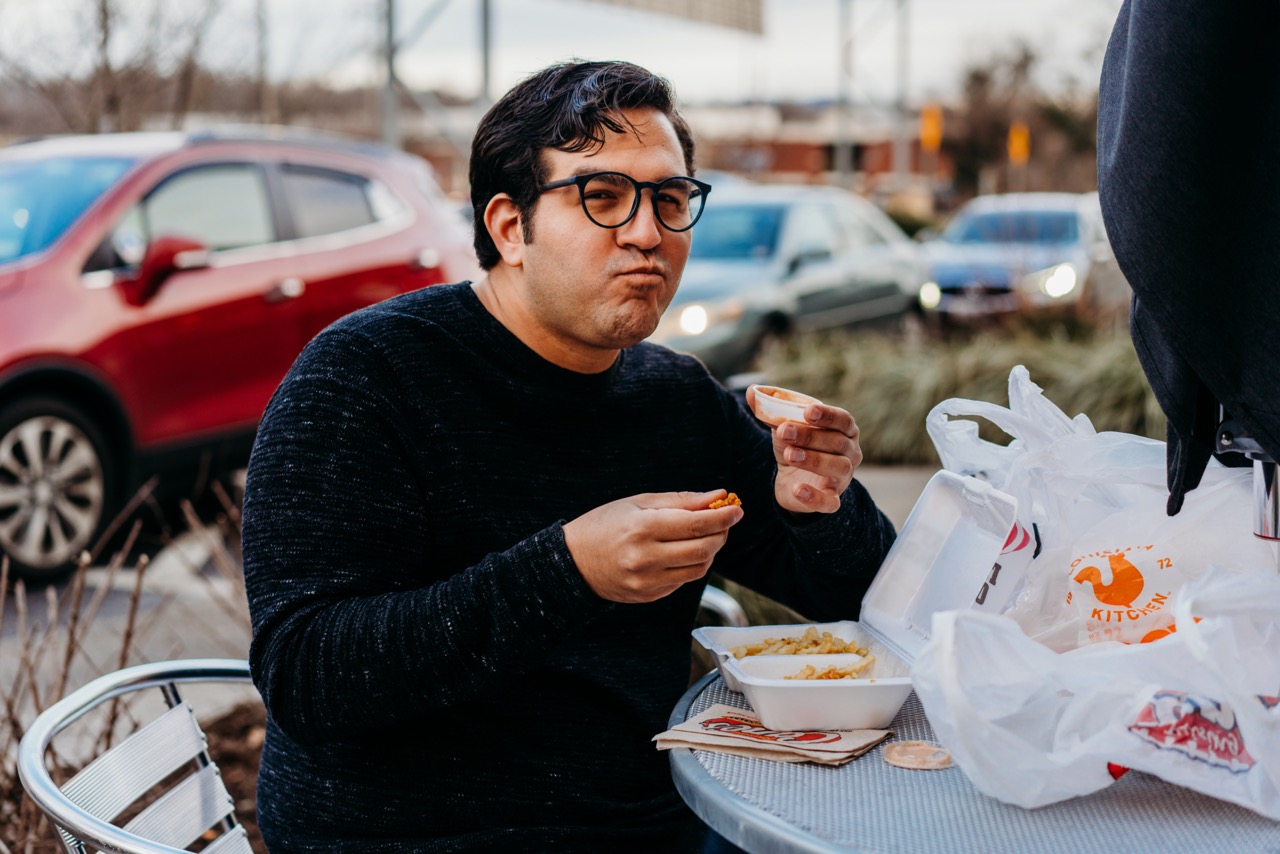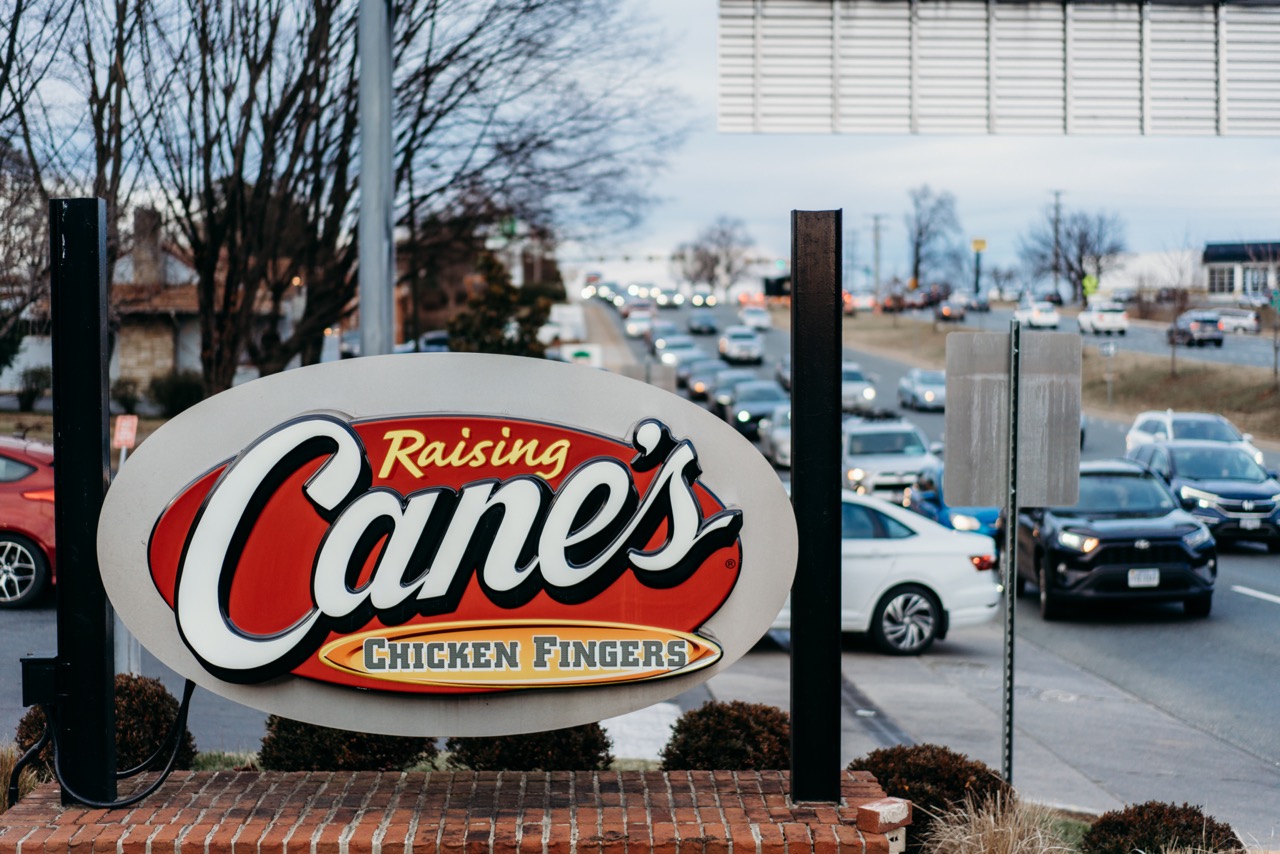How much do I want fried chicken?
That question haunted me. It began as a simple test of endurance: How long was I willing to sit in traffic to get lunch? But as I initiated that test again and again, at different hours and on different days, the question began to transform—to molt, much like a chicken sheds its feathers, and take on new meaning. Truly, I wondered, how much do I want fried chicken?
I had a lot of time to be in that headspace, to consider that question and ponder other mysteries of life, as I waited in the drive-thru line at Raising Cane’s Chicken Fingers. The Cane’s drive-thru is one of the great wonders of Charlottesville: a big disruptive living landmark that’s become equal parts meme and public nuisance. Cane’s is the first of three chicken restaurants on Emmet Street (Route 29), just a stoplight away from a crowded highway interchange with US 250. At peak hours, the drive-thru line will snake out onto Emmet and clog up traffic all the way to Hydraulic Road.
Raising Cane’s is well aware of the problem; the franchise has an official sign politely asking drivers not to block traffic (they do it anyway). City police patrolled the line at times last year, but now the drive-thru is monitored by armed private security.

In truth, it’s not just a Charlottesville issue. When visiting my sister in Herndon, I witnessed another Cane’s drive-thru with an absurdly long line that reached across multiple parking lots. And on a recent “Saturday Night Live,” we got the signal that this was a national problem.
“You gotta get hard in that left lane,” Andrew Dismukes shouts in a sketch about avoiding the traffic, aping a harsh Texas accent and pounding his fist into his other hand for emphasis. “’Cause if you stay even one second in the right lane, you’ll get stuck in the massive overflow line for the new Raising Cane’s.”
“This restaurant is prohibitively popular, y’all,” shouts James Austin Johnson. “The line backs up to the light, on to the offramp, and into the highway. Do not stay in the right lane!”
But perhaps unique to Charlottesville is Cane’s positioning at the beginning of what’s been derisively deemed “chicken alley” or the “chicken strip”—that tight stretch of road where Cane’s, Popeye’s, and KFC all reside (not to mention Zaxby’s, Cook Out, Arby’s, and Cava across the street). However, the same lines don’t plague these other chicken restaurants; just take a look, their drive-thrus are bare. I spoke with a manager at KFC, who told me that the way the chicken strip is laid out, with the Cane’s queue at the front and a stoplight at the end, it directly affects their business by making the right lane largely inaccessible. A drive-thru server at Popeye’s concurred.
C.J. Ghotra, co-owner of Milan, the restaurant that precedes Cane’s on the strip, says they often receive complaints from customers who are unable to get to the parking lot during rush hour, and that the obstruction has cost them business.
So, I wanted to know: Why Cane’s? Is its chicken so good that people are willing to burn away fuel and time waiting to get it? Before this story, I had never eaten at a Raising Cane’s. We had one in Richmond, right by the VCU campus, which was never as busy as the Charlottesville drive-thru. I was determined to find out what made this one so special.

It takes me 12 minutes to get from my apartment to Cane’s. I got there around 1:30pm on a Saturday, poised to experience the dreaded wait, but I was surprised to see the drive-thru line had yet to extend into the street. I was the last to enter the parking lot, just narrowly pulling the rear of my car in. Anyone who wanted chicken after me would be out on the road.
The dining room was open, a change from the height of the pandemic when drive-thru was the only option. I thought that would perhaps explain the not-so-bad traffic. But the line was slow. “Proud Mary” blasted over the outdoor speakers. I saw a Chick-fil-A bag in a trash can outside—signs of the chicken multiverse—and a security vehicle standing by while two armed guards hovered nearby, each clad in black with sunglasses and tough boots.
I rounded the bend and saw the menu. Raising Cane’s serves one meal—chicken fingers, fries, and Texas toast—four different ways. You can order three, four, or five fingers, or throw three on a bun and call it a sandwich. That’s it. It’s a simple menu.
I ordered Our Favorite, the Box Combo: four chicken fingers, crinkle-cut fries, Cane’s sauce, Texas toast, coleslaw, and a fountain drink. The server who handed me my food said, “You look like Clark Kent.”
“Do you turn into Superman when you take off your glasses?”
I said, “Maybe!”
I got my food, parked to eat, and immediately realized I’d made a grave mistake. Two o’clock was evidently the witching hour. Cars were honking and the road was blocked. An endless line began to form behind me. A security guard roamed up and down the queue. I was trapped in the parking lot with no room to back up. I did not feel like Superman. I felt like Clark Kent.
Why couldn’t I just wait to eat at home? Because I wanted to have my meal fresh, to give it a fair shake.
But before I say anything about Cane’s food, I need to make one thing clear: I am not a chicken expert. I don’t have a white or dark meat preference. I’ve never fried chicken at home, so I don’t have any hot takes on seasoning or sauces. I couldn’t tell you whether bone-in wings or boneless wings are superior. (I prefer boneless because I don’t have to navigate my teeth around something I’m going to throw away.)


That said, Cane’s is fine. Yet I don’t understand what all the hubbub is about, why people are so gaga for this chicken.
“Chicken tasted like it was made by my Auntie,” writes Keyonna Adkins in a Google review of the Charlottesville Raising Cane’s.
“Best chicken ever!” writes Greg Morris.
“The chicken fingers I got were crispy on the outside and juicy on the inside, and that’s the way, uh huh, uh huh, I like it!” writes Oliver C. on Yelp.
But not everyone is convinced.
“Raising Cane’s affirms my belief that bistros that strongly tout their own sauce, are probably using that sauce to compensate for a rather bland product,” writes Kimberly-Gretchen B. on Yelp.
One constant refrain, of course, was the very long line that spills onto Emmet Street. Many Google and Yelp reviews—both positive and negative—reference the line, or, even worse, accidents on the road. According to VTrans interactive map data, which visualizes transportation data across the commonwealth, 19 accidents happened on US 29S specifically on the chicken strip between January 2022 and January 2023, with at least one injury marked as “severe.”
“No chicken is worth a life,” writes Traci E. on Yelp.
The issue isn’t solely Cane’s. The restaurant clearly doesn’t have a big enough lot for its drive-thru traffic. And according to CBS19, it’s the result of a curious zoning issue. Restaurants in the area require a special city permit to be a drive-thru business, working with the city traffic engineer to make sure there’s enough space for a considerable line. The building housing Cane’s predates that requirement.
“There’s really not a whole lot we can do in this particular location,” Brennen Duncan, Charlottesville’s city traffic engineer, told CBS19 in November. “We can’t shut down a whole lane of travel and designate it as the drive-thru lane, nor would we want to.”
That leaves the task to the Virginia Department of Transportation, which “has put some money into” solutions, says Lee Kondor, the chairman of the city’s Citizens Transportation Advisory Committee. CTAC and VDOT, Kondor says, are well-aware of the backup on Emmet Street, but proposals that would alleviate the congestion tend to hypothetically break the bank.
“No question, it’s expensive,” he says. “VDOT says it’s too expensive and they’re the ones that are in control of the situation.”
VDOT has considered a number of solutions for the chicken strip, such as making some improvements to Angus Road, just south of KFC, and adding a connector road behind the restaurants (which didn’t go anywhere).
Right now, its biggest and brightest idea to address the traffic problem is to eliminate left turns from Hydraulic Road onto US 29. But to Kondor, that creates a whole other set of problems. In his proposal for a much more elaborate solution—a new flyover road option that would travel up over Hydraulic, over Angus Road and connect to the 250 Bypass—he writes that, “Eliminating left turns from Hydraulic Road onto US 29 means that the traffic that would have turned left has to proceed straight across US 29, make a U-turn, proceed back to US 29, and turn right.” To address this new problem, roundabouts are proposed at particular intersections affected by the U-turns. The whole thing just sounds like a mess.
“If you’re westbound on Hydraulic and want to turn onto 29 southbound, I don’t know what you’ll do,” Kondor says.
His proposed flyover didn’t exactly soar.
“I estimated that would cost $50 million,” he says, “which is about what VDOT is proposing to eliminate the left turn off of Hydraulic.”
Apparently VDOT’s engineers took a look at his idea and came back with a new price tag that had a couple more zeros. It wasn’t going to happen.
Right now, says Kondor, the only funding available is for minor changes to US 29 and the Hydraulic Road intersection, like eliminating that left turn. That’s all that’s on the horizon for the next five or 10 years. If you want something more substantial, the 2050 Long-Range Transportation Plan might be your best bet, if you’re willing to wait that long.
I went back to Raising Cane’s several times after my first excursion, eager to see the drive-thru line at its biggest and baddest. But soon I realized that my research, my attempt to sample every chicken restaurant on the strip, was only contributing to the problem. As my car hung out into the street, a woman in a Mini Cooper threw her hands up behind me, trapped in chicken purgatory. She laid on the horn as she went around me.
It made me wonder why I was doing this—what was the point? To annoy myself? To annoy others? Everyone knew that the line was long, that it was for subpar chicken, and that it wasn’t getting any shorter. But I was here to experience it, to try to understand why it was so damn long.
My final journey to the chicken strip was my greatest in scope and potential danger. I planned to round all three drive-thru lines at Cane’s, Popeye’s, and KFC, and order chicken fingers from each establishment to compare. Each combo’s calories tallied into the quadruple digits. My body shuddered at what it’d have to digest. I thought I would be eating leftovers for a while, so I braced my stomach—and fridge—for impact.
The distinct peppery smell of Popeye’s wafted down the wind on a chilly Sunday evening as I stood outside for photos, clutching my takeout bags in each fist. And there it was: as the sunlight faded, I finally saw the full length of the Cane’s line with my own eyes. It was backed up all the way to the Hydraulic intersection. The way the road slopes up north gave me a full view of the traffic, as drivers honked their horns in staccato rhythm. Trapped in the right lane as the middle and left lanes zoomed by, there was no escape, whether you wanted chicken or not.
